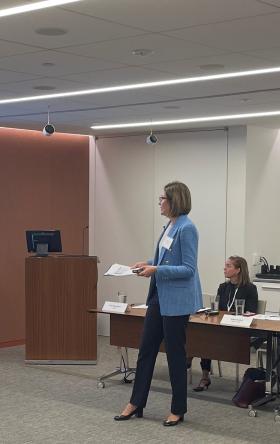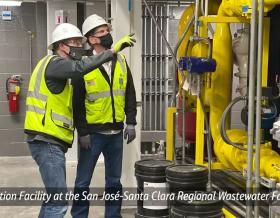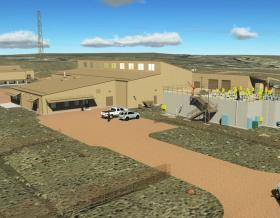
The long-term management and effective remediation of per- and polyfluoroalkyl substances (PFAS) at U.S. military sites presents a complex challenge because the widespread use and release of products containing the “forever chemicals” has been ongoing for decades. In the United States, the Environmental Protection Agency (EPA) estimates there are more than 120,000 PFAS-affected sites, each with its own set of complexities and characteristics. For the Department of Defense (DOD), which is uniquely impacted by PFAS due to the years of aqueous film-forming foam usage, the challenge of addressing hundreds of installations throughout the United States and its territories is further layered with the complexity of needing to often identify, manage, and remediate multiple release areas at individual bases or facilities.
The scale of the problem was brought into sharper focus in April 2024 when the EPA announced regulations to limit certain PFAS in drinking water to as low as 4-ppt while also designating certain PFAS compounds subject to actions mandated by the Comprehensive Environmental Response, Compensation, and Liability Act.
In response to these new regulations, DOD is continuing to take active steps to identify and remediate PFAS. However, the need for regulatory compliance at the federal level while efficiently and effectively managing a diverse and large portfolio of liabilities may benefit from several paradigm shifts in thinking.
Framework in action
The approach that Jacobs has taken to the PFAS investigation and management for a portfolio of 37 airports outside the United States provides a relevant example that may be transferrable to the Defense Department.
The airports are located across a continent with a diverse range of geographic, climatic conditions, and local jurisdiction-based regulations. To implement an investigation of this scale presented numerous challenges beyond the technical aspects of determining the nature and extent of PFAS contamination. Key factors such as stakeholder interests (airport operators, airlines, and regulators) and data management significantly influence the program’s success.
In response to this challenge, Jacobs developed a PFAS Investigation Framework that enhances existing regulations and guidance to ensure that parallel investigation occurring at multiple sites are undertaken in a standardized way. This commitment to ensure consistency in investigation strategy, interpretation of results, and reporting aims to eliminate variation between sampling strategies. This enables a meaningful comparison of contamination significance across different areas within the same airport, as well as between different locations.
In turn, this approach not only achieves significant cost savings but provides the foundation for program-wide prioritization of management and/or remediation actions that can be shared with stakeholders.
Role of technology
The challenges of PFAS have accelerated the research, development, and deployment of a next generation of scientific knowledge and technology. The use of these novel approaches can enhance how the environmental engineering community can establish the highest defensible standards at an accelerated pace—meeting regulatory requirements and aligning with the expectations of DOD and installation stakeholders.
Digital enhancements. A foundational principle in tackling environmental remediation sites is understanding the source of the problem. This is a step that cannot be overlooked. Following best practices means using multiple lines of evidence and site data to ensure that remedial action is rooted in a solid understanding of the conceptual site model, the source areas, and the transport occurring at a location.
Emerging digital fingerprinting (source identification) technology identifies specific PFAS compounds and distinguishes contamination that may originate from differing sources.
Digital processes compare source area and downgradient fingerprints, map transformation pathways, and then ensure that solution providers understand the release history and the problem that needs to be tackled. Digital technology further augments human expertise by supporting data analysis and identifying trends and correlations in the data that can reveal important clues to tackling a PFAS problem. Data can be visualized in dashboards to inform decision-making and support stakeholder understanding and engagement in a transparent and consistent format.
A commitment to robust PFAS source identification, enabled with the right digital tools, avoids wasting time and money on a flawed conceptual site model. Understanding the problem to be solved also allows the DOD to meaningfully chart a path to resolve the problem and stop the issue at the source. This minimizes costly ongoing downgradient treatment and further erosion of community trust.
Toxicology assessments. As regulatory frameworks evolve and add more PFAS as compounds of concern, there is a need for the next generation of practitioners to change how the industry assesses PFAS risk to human health. At the center of this challenge is the need for toxicology assessments to pivot from animal and human assessments to a cellular-based methodology—a current requirement under the federal Toxic Substances Control Act (2016).
While this change represents a major shift in how toxicology and risk are assessed in environmental restoration, it is overarchingly positive as it will leverage state-of-the-science methods and improvements in the understanding of human toxicology.
In the chemical testing and manufacturing industry, best practice is already focused on the development and delivery of New Approach Methods (NAMs); these innovative courses of action provide toxicity information using cellular-based methodology. NAMs not only reduce animal testing, but they limit scientific uncertainties and can facilitate quicker and less expensive toxicity assessments for the expanding list of PFAS.
NAM risk assessments provide defensible risk evaluations more accurately tailored to the PFAS compounds of concern at a specific site, as well as incorporating realistic and reasonable exposure scenarios. The need to embrace the application of these new risk evaluation methods could not be more relevant than it is to the emerging class of PFAS.
Combining expertise
The DOD is additionally faced with regulatory, contracting, and financial constraints resulting from PFAS. This can result in the investigation and remedial phases at known sites being performed by a range of separate entities. However, this approach increases the potential for inefficiencies in execution and inconsistencies in the implementation of policies and procedures (while also extending schedules and creating changing stakeholder groups).
Against the backdrop of the EPA’s new regulatory framework, the DOD may benefit from more cohesive programmatic frameworks that draw together consistent technical, project management, and stakeholder engagement expertise to deliver program-wide expertise.
This type of holistic approach can mean solution providers are able to leverage historical knowledge and practices with defense partners on a long-term basis, delivering both cost savings and greater productivity. Centralized data management and operating procedures can accelerate and enhance consistency in mitigating PFAS liabilities across multiple government installations. And since some DOD locations are still at the early investigation stages, whereas others are entering more complex remediation phases, lessons learned and positive outcomes achieved at more mature sites can be readily applied elsewhere at the early stage of the lifecycle. This is crucial to accelerating the department’s overall PFAS response as well as presenting consistent, defensible approaches to local regulators and affected communities.
Addressing complexity
The PFAS challenge is significant. However, coupling the environmental industry’s experience addressing large, complex issues with next generation digital and toxicology advancements, and bringing that expertise to bear in an integrated holistic approach can likely accelerate progress. Implementing consistent, defensible remediation approaches can help provide transparent decision-making and stakeholder involvement.
As regulatory and public pressures to address PFAS increase, grounding the DOD’s approach in a consistent holistic framework provides many benefits and efficiencies, with a clear opportunity to advance progress in addressing a seemingly ever-expanding challenge.
The Military Engineer, Volume 117, Issue 755, January-February, pages 57-59, Copyright 2025. Reprinted with permission of the Society of American Military Engineers (SAME).
About Sharon
Sharon Minchak serves as Jacobs’ Global Solutions Director for Remediation & Regeneration. She is a licensed Professional Geologist with a bachelor's in geosciences from The Pennsylvania State University and a master's in earth and planetary Sciences from the University of New Mexico. Sharon has 30+ years of global experience serving a diverse set of government and private sector clients, working across all aspects of the Environmental market from planning and permitting, to regulatory compliance and sustainability, to investigation, remediation and regeneration.
Considered a leading subject matter expert in the Remediation & Regeneration space, Sharon has specific experience with emerging contaminant assessment, characterization, treatment and research across multiple sectors, including water, transportation, private and federal portfolios, including Superfund sites. Outside of work, Sharon loves cooking, gardening, hiking, camping and generally being outside. She’s a geologist by training and professionally, but also really enjoys visiting beautiful places with notable geologic features and great rocks!














































